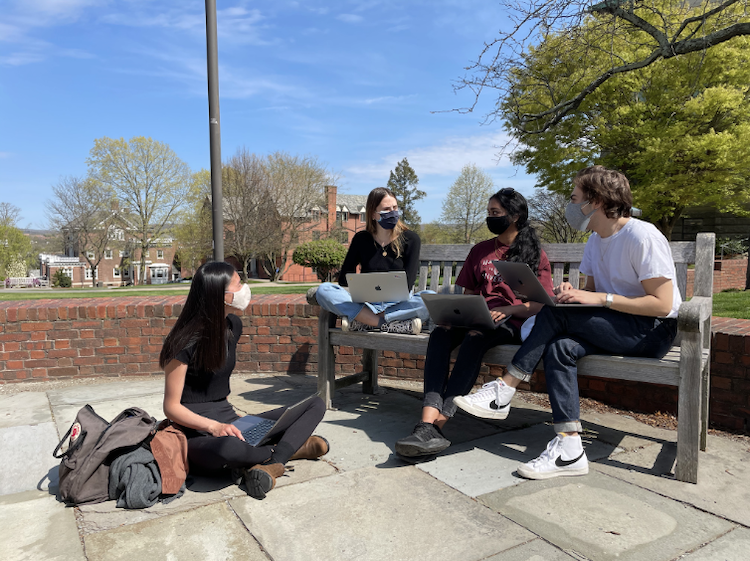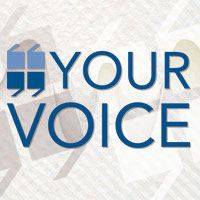Solving civil justice issues in the classroom

A small group work on their community partner research project. Photo courtesy of Alyx Mark.
Throughout my time as an access-to-justice scholar, I have noticed a meaningful gap in our collective understanding of the scope of civil justice problems in the United States and of the real work needed to address the access-to-justice crisis.
We don’t know how many people experience a civil justice problem each year, but scholars estimate tens of millions of people face at least one. Can we address the access-to-justice gap by looking to courts and the legal profession alone for answers?
Probably not, as the vast majority of people confronting problems with their housing, health care or families—among other types of civil justice issues—do not enter the formal legal system to solve them. Instead, they seek advice from friends, family and community figures, or ignore their problems entirely, chalking their situations up to “bad luck.”
I’ve studied access to civil justice, U.S. legal systems and legal regulation for a decade. My work has explored the connection between legal empowerment and a person’s visit to a legal aid office, the varied roles judges play in managing litigation and shaping parties’ experiences. And I’ve recently launched studies of Utah’s legal regulatory reform projects and of the impact the pandemic has had on the operations of state civil courts.
In the vast majority of these projects, I’ve collaborated with legal academics who infuse access-to-justice lessons into their courses and clinical work, as well as into the general legal education discourse.
The renowned access-to-justice scholar Rebecca Sandefur explains that judges and lawyers “work at the top of an enormous iceberg of civil justice activity”—many of which threaten the basic human needs of the poor and of racial minorities.
When we reorient ourselves to appreciate what’s above and below the waterline, we gain a better appreciation of the scope of the research needed to understand and address the access-to-justice crisis. Sandefur further argues that this new perspective allows us to look outside of the law for solutions—thus encouraging the profession’s collaboration with new voices.
This past spring, I had the opportunity to design and launch an access-to-civil justice course at Wesleyan University, where I teach in the government department. This course delved beneath the surface to investigate the path justiciable problems take from the bottom of the civil justice iceberg to the top, studying the actors, rules and processes people with justice problems encounter as they identify and resolve them.
Undergraduate courses like these expose students interested in joining the legal profession to the realities of our justice system. They also kick-start a healthy pipeline to civil justice-oriented careers, helping to inspire new generations of lawyers and nonlawyers alike to work together to develop equitable solutions to access-to-justice problems.
I taught the course in partnership with an access-to-justice civil justice field expert—Zach Zarnow of the National Center for State Courts—who facilitated relationships with our community partners and contributed a practitioner’s perspective to our class discussions.
The class incorporated service learning, with the students collaborating directly with community groups, designing research projects responsive to the access-to-justice questions raised by the groups. Students were introduced to a range of thought leaders in the areas of legal technology, education, research and service provision—made easier with the use of Zoom.
Understanding civil justice problems
Through class discussions about the meaning of access to justice and how gaps in access should be addressed, students were challenged to imagine justice beyond the legal system in addition to within it.
Our class conceptualized solutions to access-to-justice issues as more than merely increasing the funding for legal services—students learned that we must work to help people understand the ways in which their civil justice problems can be addressed and recognize that these methods might vary according to both community and individual needs.
One student group collaborated with a legal services provider in an effort to identify how the provider could reach underserved communities. As they expected—and consistent with the research in the field—financial resources and proximity to legal services offices and courts contributed to people’s level of access.
But their project also spoke to an idea we discussed frequently—that access barriers go far deeper. For example, someone with a civil justice problem may not know their problem has a legal resolution in the first place. Or, that person might live in a small community and have anxiety about feeling exposed as a result of seeking legal help.

In-person members of the course in their Sandefur-inspired, student-designed ‘Ask me about this iceberg’ T-shirts, with class mascot Smudge the corgi in the arms of the course’s community partner liaison, Zach Zarnow of the National Center for State Courts. Photo courtesy of Armando Alvarez.
Creating spaces for nontraditional voices
Through their conversations with peers and guest speakers, students realized that tackling access-to-justice issues will require bringing nonlawyers—those with different professional backgrounds and experiences—into the conversation.
Another group’s research project focused on improving grantmaking to civil justice nonprofits. In their interviews with organizations funded by their partner group, the students learned that organizations tended to be more confident that their work was represented correctly in grantmaking and evaluation processes when funders brought nonlawyers into the conversation.
And while the students recognized that there is great difficulty in introducing new elements into a field framed by tradition, they remarked that they felt the field must accept and support the introduction of new individuals from many professional and personal backgrounds in order to enhance access to, and encourage participation in, the civil legal system.
The difficulties of creating an evidence base
Course readings and their work with community partner groups led students to appreciate the role evidence-based research plays for improving access to justice. They also discovered that it is quite difficult to identify and collect the data necessary to do this research.
Students working with a nonprofit civil justice advocacy organization confronted these hurdles in their efforts to collect data on the professional diversity of a state’s trial bench; the data they were seeking was often missing, private or from an unreliable source.
These research impediments prevented the group from accurately describing the professional and demographic composition of the bench. Without a baseline measure, they found that it was also difficult to make the claim that the bench needed to be more professionally and demographically diverse.
In addition to the benefits of improved data access for research and advocacy, they saw a public value in making these data available, as this could also enhance people’s trust in legal institutions and their decisions.
Leveraging pandemic learnings
Finally, and perhaps most importantly, the class worked through issues related to civil justice with the pandemic as a backdrop. The accessibility of virtual trials and hearings allowed them to further apply their theoretical class discussions to real-time observations of legal proceedings around the country. They also could contemplate innovative ways of addressing civil justice problems.
The students discussed how the use of technology could expand court accessibility and convenience, and they considered where and how dispute resolution methods employed outside of the legal system could be effective tools for resolving legal problems.
Above all, a consistent thread in our conversations was an emphasis on the need to eradicate systems of inequality in areas such as housing and health care as far upstream as possible, to not only reduce the overwhelming demand on the courts, but to achieve justice before a dispute even occurs.
There is no straightforward path to addressing questions of access, but I believe these students will be part of the hard work to come. In their three years of law school and their future careers, they will challenge our definitions of “access to justice” and will continue to develop skills and expertise relevant to the conversations ahead.
Alyx Mark is an assistant professor of government at Wesleyan University and an affiliated scholar at the American Bar Foundation. Her research focuses on access to justice, American state and federal courts and the regulation of the legal profession.
Editor’s note: This column was written in collaboration with Wesleyan University students Kathryn Campbell, class of 2022, majoring in history; Ariel Deutsch, class of 2021, double majoring in the college of social studies and Italian studies; Leïla Patsalides, class of 2023, double majoring in neuroscience and psychology; and Harriet Winterlich, class of 2022, a junior double majoring in government and history.
ABAJournal.com is accepting queries for original, thoughtful, nonpromotional articles and commentary by unpaid contributors to run in the Your Voice section. Details and submission guidelines are posted at “Your Submissions, Your Voice.”
Your Voice submissions

The ABA Journal wants to host and facilitate conversations among lawyers about their profession. We are now accepting thoughtful, non-promotional articles and commentary by unpaid contributors.

